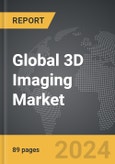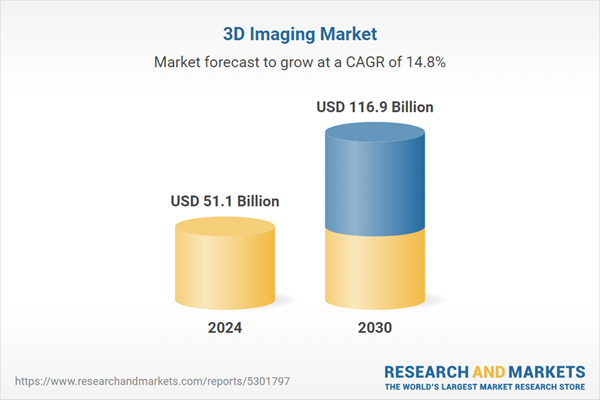Global 3D Imaging Market - Key Trends and Drivers Summarized
What Is 3D Imaging and How Does It Work?
3D imaging is a cutting-edge technology that captures the depth, shape, and texture of objects or environments, creating a three-dimensional representation that can be viewed and manipulated in digital form. Unlike traditional 2D imaging, which captures only the length and width of an object, 3D imaging captures the third dimension - depth - allowing for a much more detailed and realistic depiction. The process of creating a 3D image typically involves a combination of specialized hardware and software. Various techniques can be used, such as laser scanning, stereo vision (capturing two images from slightly different angles to simulate human vision), and structured light, where patterns of light are projected onto an object, and the distortion of the light is used to map its surface. The resulting data is then processed into a 3D model or image that can be viewed from different angles, rotated, or rendered into virtual environments. This technology is widely used across many industries, including healthcare, entertainment, manufacturing, and even archaeology, due to its ability to provide highly detailed and accurate representations of objects and spaces. As 3D imaging continues to advance, its applications are expanding, offering more precise tools for professionals and enhancing everyday visual experiences for consumers.How Is 3D Imaging Transforming Different Industries?
3D imaging is having a transformative impact across a range of industries, redefining how professionals visualize and interact with complex data and objects. In healthcare, 3D imaging technologies such as MRI (Magnetic Resonance Imaging), CT (Computed Tomography), and ultrasound are used to create detailed, three-dimensional images of internal body structures. These images are invaluable for diagnosing medical conditions, planning surgeries, and even guiding real-time surgical procedures, allowing doctors to see organs, tissues, and bones with remarkable clarity and precision. In the entertainment industry, 3D imaging has revolutionized the creation of visual effects, animation, and immersive experiences. Movies, video games, and virtual reality (VR) environments all rely on 3D imaging to create lifelike characters and worlds that draw viewers into entirely new realms of visual storytelling. Similarly, in manufacturing and engineering, 3D imaging is used to design, prototype, and inspect products. This technology enables designers to visualize parts and assemblies in three dimensions, ensuring accuracy and quality before moving to production. Another area where 3D imaging is gaining ground is in construction and architecture, where it allows for the creation of detailed 3D models of buildings and structures. These models enable architects and engineers to simulate real-world conditions, optimize designs, and improve collaboration with clients and stakeholders. From medical diagnostics to design and entertainment, 3D imaging is changing the way we perceive and interact with the world, offering new levels of detail and realism.What Are the Challenges and Limitations of 3D Imaging?
Despite the exciting potential of 3D imaging, there are several challenges and limitations that hinder its wider adoption and usage. One of the primary challenges is the high cost of 3D imaging equipment and software. Advanced systems, such as those used in medical imaging or industrial design, often require expensive hardware, including specialized cameras, scanners, or sensors, as well as powerful computers to process the large amounts of data generated. This can make 3D imaging technology inaccessible to smaller businesses or professionals without substantial investment. Additionally, the complexity of using 3D imaging systems presents another barrier. Creating high-quality 3D models often requires specialized knowledge and technical expertise, limiting its use to trained professionals in fields such as healthcare, architecture, or industrial design. Data storage and processing also present challenges, as 3D imaging generates large datasets that require significant computational power and storage capacity. This can slow down workflows and increase costs, especially for businesses handling multiple 3D projects at once. Furthermore, 3D imaging systems can sometimes struggle with capturing accurate data in certain environments or for specific objects. For example, reflective surfaces, poor lighting conditions, or highly detailed textures may cause distortions or gaps in the 3D model, leading to inaccuracies. Finally, privacy concerns are also emerging, particularly in sectors like retail and security, where 3D imaging is used for facial recognition or personal data collection. Overcoming these challenges will require advancements in technology, cost reduction, and improved user accessibility for 3D imaging to reach its full potential.What Factors Are Fueling the Growth of the 3D Imaging Market?
The growth in the 3D imaging market is driven by several factors that underscore the increasing demand for more immersive, precise, and versatile visualization tools. One of the primary drivers is the rising demand for enhanced imaging solutions in healthcare. The increasing prevalence of chronic diseases, the aging population, and the need for advanced diagnostic tools are pushing hospitals and clinics to adopt 3D imaging technologies, such as 3D MRIs and ultrasounds, to improve patient outcomes and streamline medical procedures. Additionally, the entertainment and media sectors are embracing 3D imaging for the creation of realistic visual effects, animated films, and virtual reality experiences. The continued growth of VR and augmented reality (AR) applications in gaming, education, and retail is boosting demand for 3D imaging systems that can create lifelike, immersive environments. The increasing focus on automation and precision in industries such as manufacturing, automotive, and aerospace is also driving the adoption of 3D imaging. These industries rely on the technology to enhance product design, quality control, and prototyping, enabling more efficient and cost-effective manufacturing processes. Furthermore, advancements in smartphone cameras and sensors have made 3D imaging more accessible to consumers, driving demand for applications such as 3D photography, facial recognition, and AR-based shopping experiences. Governments and academic institutions are also investing heavily in 3D imaging research and development, particularly in areas such as security and urban planning, where the technology can be used for surveillance, mapping, and infrastructure management. These factors, along with ongoing technological advancements that continue to lower costs and improve the quality of 3D imaging systems, are fueling the rapid growth of the 3D imaging market across multiple industries.SCOPE OF STUDY:
The report analyzes the 3D Imaging market in terms of units by the following Segments, and Geographic Regions/Countries:- Segments: Component (Hardware, Services, Solutions); Deployment (On-Premise, Cloud); End-Use (Healthcare & Life Sciences, Aerospace & Defense, Automotive & Transportation, Manufacturing, Architecture & Construction, Media & Entertainment, Retail & Consumer Goods, Other End-Uses)
- Geographic Regions/Countries: World; United States; Canada; Japan; China; Europe (France; Germany; Italy; United Kingdom; Spain; Russia; and Rest of Europe); Asia-Pacific (Australia; India; South Korea; and Rest of Asia-Pacific); Latin America (Argentina; Brazil; Mexico; and Rest of Latin America); Middle East (Iran; Israel; Saudi Arabia; United Arab Emirates; and Rest of Middle East); and Africa.
Key Insights:
- Market Growth: Understand the significant growth trajectory of the Hardware segment, which is expected to reach US$49.3 Billion by 2030 with a CAGR of a 14.7%. The Services segment is also set to grow at 16.5% CAGR over the analysis period.
- Regional Analysis: Gain insights into the U.S. market, valued at $13.5 Billion in 2024, and China, forecasted to grow at an impressive 22.5% CAGR to reach $32.3 Billion by 2030. Discover growth trends in other key regions, including Japan, Canada, Germany, and the Asia-Pacific.
Why You Should Buy This Report:
- Detailed Market Analysis: Access a thorough analysis of the Global 3D Imaging Market, covering all major geographic regions and market segments.
- Competitive Insights: Get an overview of the competitive landscape, including the market presence of major players across different geographies.
- Future Trends and Drivers: Understand the key trends and drivers shaping the future of the Global 3D Imaging Market.
- Actionable Insights: Benefit from actionable insights that can help you identify new revenue opportunities and make strategic business decisions.
Key Questions Answered:
- How is the Global 3D Imaging Market expected to evolve by 2030?
- What are the main drivers and restraints affecting the market?
- Which market segments will grow the most over the forecast period?
- How will market shares for different regions and segments change by 2030?
- Who are the leading players in the market, and what are their prospects?
Report Features:
- Comprehensive Market Data: Independent analysis of annual sales and market forecasts in US$ Million from 2024 to 2030.
- In-Depth Regional Analysis: Detailed insights into key markets, including the U.S., China, Japan, Canada, Europe, Asia-Pacific, Latin America, Middle East, and Africa.
- Company Profiles: Coverage of players such as Able Software, Adobe, Autodesk, Bentley Systems, Dassault Systèmes and more.
- Complimentary Updates: Receive free report updates for one year to keep you informed of the latest market developments.
Some of the 34 companies featured in this 3D Imaging market report include:
- Able Software
- Adobe
- Autodesk
- Bentley Systems
- Dassault Systèmes
- ESRI
- FARO
- GE Healthcare
- HP
- Lockheed Martin
- Maxon
- Panasonic
- Philips
- Pix4d
- Pixologic
- Sony
- Stmicroelectronics
- Topcon
- Trimble
This edition integrates the latest global trade and economic shifts as of June 2025 into comprehensive market analysis. Key updates include:
- Tariff and Trade Impact: Insights into global tariff negotiations across 180+ countries, with analysis of supply chain turbulence, sourcing disruptions, and geographic realignment. Special focus on 2025 as a pivotal year for trade tensions, including updated perspectives on the Trump-era tariffs.
- Adjusted Forecasts and Analytics: Revised global and regional market forecasts through 2030, incorporating tariff effects, economic uncertainty, and structural changes in globalization. Includes segmentation by product, technology, type, material, distribution channel, application, and end-use, with historical analysis since 2015.
- Strategic Market Dynamics: Evaluation of revised market prospects, regional outlooks, and key economic indicators such as population and urbanization trends.
- Innovation & Technology Trends: Latest developments in product and process innovation, emerging technologies, and key industry drivers shaping the competitive landscape.
- Competitive Intelligence: Updated global market share estimates for 2025, competitive positioning of major players (Strong/Active/Niche/Trivial), and refined focus on leading global brands and core players.
- Expert Insight & Commentary: Strategic analysis from economists, trade experts, and domain specialists to contextualize market shifts and identify emerging opportunities.
- Complimentary Update: Buyers receive a free July 2025 update with finalized tariff impacts, new trade agreement effects, revised projections, and expanded country-level coverage.
Table of Contents
Companies Mentioned (Partial List)
A selection of companies mentioned in this report includes, but is not limited to:
- Able Software
- Adobe
- Autodesk
- Bentley Systems
- Dassault Systèmes
- ESRI
- FARO
- GE Healthcare
- HP
- Lockheed Martin
- Maxon
- Panasonic
- Philips
- Pix4d
- Pixologic
- Sony
- Stmicroelectronics
- Topcon
- Trimble
Table Information
| Report Attribute | Details |
|---|---|
| No. of Pages | 379 |
| Published | October 2025 |
| Forecast Period | 2024 - 2030 |
| Estimated Market Value ( USD | $ 51.1 Billion |
| Forecasted Market Value ( USD | $ 116.9 Billion |
| Compound Annual Growth Rate | 14.8% |
| Regions Covered | Global |









